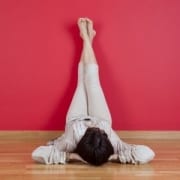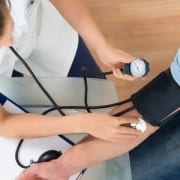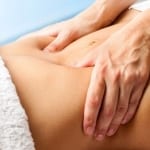Return to the Heart
How to Avoid Blood Clots and Other Circulatory Health Problems While Flying
Recently, I flew from Colon, Panama, to Dallas, Texas, and then home to Dulles, Virginia – a total of 7 hours on planes. Wow, were my arms tired!
Actually, it wasn’t really my arms that were bothering me at the end of that flight. It was my feet, ankles, and lower legs. They were sore, and they had swelled up so much that they scared me. This had never happened to me before. I made an appointment with Physical Therapist Jessica Coleman, who walked me through the ABC’s of in-flight self-care.
It turns out that I did exactly the wrong things:
- I SAT quietly, nearly motionless, for the entire 7 hours that I was flying.
- I didn’t drink a lot of fluids, so I wouldn’t have to get up and disturb the person seated beside me.
- I didn’t wear compression stockings (I had never considered them before thinking they were too ugly!).
Jessica informed me that I needed a new in-flight routine, including:
- Wearing compression stockings. She recommended “Bauerfeind Sports Compression Socks.” I now have a pair. They look normal and they are soft to the touch and super comfortable to wear. Good one, Jessica!
- Wearing loose clothing. By wearing loose clothing you will not constrict the fluid flow in your body.
- Moving. Jessica instructed me to walk the aisle periodically, as often as possible. I mentioned, “turbulence,” and she responded, “There’s a lot you can do while seated: point your toes, roll your feet in circles to keep the blood moving, turn your feet out and then in, bump your knees up and down, twist from your waist as far as you can, reach your elbows up, bend forward as much as possible to stretch your spine, tense your glutes, then relax.” Repeat every 30-45 minutes.
- Drinking lots of water. Staying hydrated enables your lymphatic system to keep fluids moving efficiently through your system. Consuming water also has the inevitable effect of leading to Step 2 above (walking the aisle to the restroom). Avoid alcoholic and caffeinated drinks because they cause fluid retention. Water is best!
And Jessica recommended one post-flight recovery step:
- Elevating your feet above your heart. Once you arrive at your destination, lay on the floor or bed, and put your legs up on a wall or headboard. Staying in this simple position for about 20 minutes has been shown to decrease the effects of jet lag and facilitate venous return to the heart, helping you to avoid blood clots. Not to mention making your back, legs, and feet feel fantastic.
If you do experience swelling in your lower limbs after air travel, consider scheduling a session with Jessica, so she can read you the riot act! Or, you can schedule a session of lymphatic massage to gently direct fluids that have accumulated in the body’s tissues back to the cardiovascular system.
On a more serious note, Jessica also pointed out that if you experience swelling and pain in only one leg, if you have a history of blood clots, or you are at an increased risk of getting a blood clot because you recently had major surgery or you are taking certain medications, you should check with your physician before you fly.
The good news: I’ve taken several long flights since February, and by following Jessica’s instructions, I have avoided a second episode of foot, ankle, and lower-leg swelling.
Thanks so much, Jessica.
– F.C.








Leave a Reply
Want to join the discussion?Feel free to contribute!